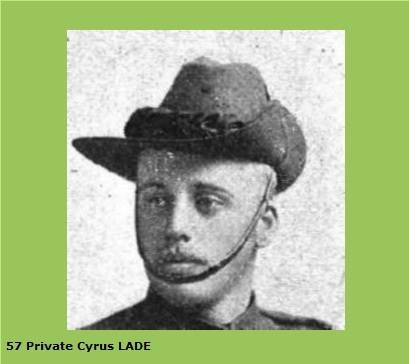|
Sergeant Cyrus Havelock Lade served with
the 1 (Tasmanian) Contingent and 1 Battalion Australian
Commonwealth Horse (ACH) during the Boer War. Lade was
born in Victoria in 1881. He enlisted with 1 (Tasmanian)
Contingent with the service number 57. The Contingent
left Hobart on the troopship 'Medic' on 28 October 1899
and arrived in Cape Town on 26 November 1899. They were
engaged in operations around Colesberg; were in the
advance upon Bloemfontein; and joined Colonel Henry's
Brigade and participated in the march to Pretoria. The
Contingent returned to Australia on 7 December 1900 on
the troopship 'Harlech Castle' and was disbanded shortly
after. Lade re-enlisted in 1 ACH in January 1902 with
the service number 1238. He left Hobart on 16 February
1902 on the troopship 'Manchester Merchant' and arrived
in Durban on 14 March. From 15 April to 28 June 1 ACH
served with the Australian Brigade and participated in
operations in the Transvaal. They returned to Australia
on the transport 'Drayton Grange' at Durban on 11 July
and arrived in Tasmania on 9 August. The unit was
disbanded on 19 August, 1902. Lade re-enlisted for
service in the First World War in 3 Light Horse
Regiment, AIF on 28 August 1914 with the service number
441. After taking part in the Gallipoli landings and in
the defence of the Nile Valley and Suez Canal, he served
in Palestine, where he died of wounds received at Gaza
on 23 April 1917.
On Saturday the Anglican rector of Port Cygnet (Rev
C.L.H. Cox) received a telegram from the military
authorities to say that Sergeant C H Lade had died of
wounds in Egypt. The deceased was a farmer and
orchardist at Randall’s Bay and saw service in the South
African campaign. Immediately the war broke out he
offered his services; subsequently he joined the Light
Horse and saw service at Gallipoli and in Egypt. He was
wounded some little time ago, but recovering, he
rejoined his regiment. Of a genial disposition, he was
very popular in the district and the news of his death
caused a gloom over the town. He leaves a widow and two
children aged six and twelve years.
The Weekly Courier 3rd May 1917
|


